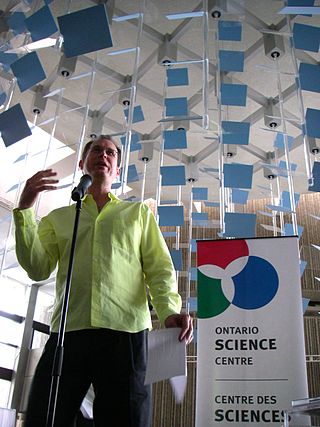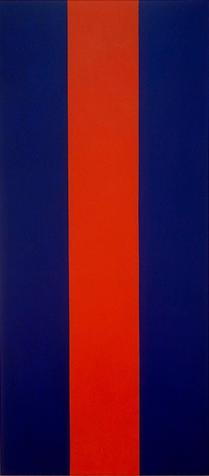Related Research Articles
Video art is an art form which relies on using video technology as a visual and audio medium. Video art emerged during the late 1960s as new consumer video technology such as video tape recorders became available outside corporate broadcasting. Video art can take many forms: recordings that are broadcast; installations viewed in galleries or museums; works streamed online, distributed as video tapes, or DVDs; and performances which may incorporate one or more television sets, video monitors, and projections, displaying live or recorded images and sounds.

David Rokeby is a Canadian artist who has been making works of electronic, video and installation art since 1982. He lives with his wife, acclaimed pianist Eve Egoyan, in Toronto, Canada.

Voice of Fire is an 1967 acrylic on canvas abstract painting made by American painter Barnett Newman in 1967. It consists of three equally sized vertical stripes, with the outer two painted blue and the centre painted red. The work was created as a special commission for Expo 67. In 1987 it was loaned to the National Gallery of Canada in Ottawa, Ontario, Canada.
Jan Peacock is a Canadian interdisciplinary artist, curator and writer.
Ross McLaren was a Canadian artist, filmmaker, and educator based in New York City.
Canadian artist-run centres are galleries and art spaces developed by artists in Canada since the 1960s. Artist-run centre is the common term of use for artist-initiated and managed organizations in Canada. Most centres follow the not-for-profit arts organization model, do not charge admission fees, pay artists for their contributions are non-commercial and de-emphasize the selling of artwork.
Rita McKeough is a Canadian interdisciplinary artist, musician and educator who frequently works in installation and performance.
Tanya Mars is a performance and video artist based in Toronto, Ontario, Canada.
Joanne Tod (R.C.A.) is a Canadian contemporary artist and lecturer whose paintings are included in the permanent collections of the National Gallery of Canada, the Art Gallery of Ontario in Toronto and the Musée des beaux-arts de Montréal.

Peggy Gale is an independent Canadian curator, writer, and editor. Gale studied Art History and received her Honours Bachelor of Arts degree in Art History from the University of Toronto in 1967. Gale has published extensively on time-based works by contemporary artists in numerous magazines and exhibition catalogues. She was editor of Artists Talk 1969-1977, from The Press of the Nova Scotia College of Art and Design, Halifax (2004) and in 2006, she was awarded the Governor General's Award in Visual and Media Arts. Gale was the co-curator for Archival Dialogues: Reading the Black Star Collection in 2012 and later for the Biennale de Montréal 2014, L’avenir , at the Musée d’art contemporain de Montréal. Gale is a member of IKT, AICA, The Writers' Union of Canada, and has been a contributing editor of Canadian Art since 1986.
Jeanne Randolph is a cultural critic, author, performance artist and psychiatrist whose work explores the relationship between art and psychoanalytic theory. She was the first writer in Canada to develop Object Relations psychoanalytic theory as a medium for cultural criticism. She introduced "ficto-criticism" In 1983 as an unprecedented method for exploring the relationship between writing and an artist's work. In universities and galleries across Canada, England, Australia and Spain she has spoken on topics ranging from the aesthetics of Barbie dolls to the philosophy of Wittgenstein.

Cheryl L'Hirondelle is a Canadian multidisciplinary media artist, performer, and award-winning musician. She is of Métis/Cree (non-status/treaty), French, German, and Polish descent. Her work is tied to her cultural heritage. She explores a Cree worldview or nêhiyawin through body, mind, emotions, and spirit; examining what it means to live in contemporary space and time.
Nell Tenhaaf is a Canadian artist, teacher, writer and feminist.

For the American jurist, see Nancy Paterson.
Sandra Brewster is a Canadian visual artist based in Toronto. Her work is multidisciplinary in nature, and deals with notions of identity, representation and memory; centering Black presence in Canada.
Lorna Boschman (1955) is a Canadian Queer media artist, film maker, curator, educator, editor, and camera operator working with themes such as sexual identity, body image, social justice, (dis)ability, cancer, abuse, health, and self-advocacy.
Âhasiw Maskêgon-Iskwêw (1958–2006) was a Cree and French Métis theorist, curator and artist. Maskêgon-Iskwêw was a significant figure in the field of contemporary Indigenous arts, and a formative proponent of digital media within Indigenous communities. In their 2015 book dedication to him, Steven Loft and Kerry Swanson describe Maskêgon-Iskwêw as "one of the foremost thinkers and practitioners of Aboriginal new media art."
Janice Gurney is a Canadian contemporary artist born in Winnipeg, Manitoba. She graduated University of Manitoba in 1973 with a Bachelor of Fine Arts Honours degree and later received a Master of Visual Studies degree from University of Toronto in 2007 with a collaborative degree in Book History and Print Culture. She went on to get a PhD in Art and Visual Culture at Western University in 2012.

Louise Liliefeldt is a Canadian artist primarily working in performance and painting. She was born in South Africa and currently lives and works in Toronto, Canada. Liliefeldt’s artistic practice draws directly from her lived experience and is apparent in the use of symbol, colour and material in her work. Other influences include Italian, Latin and Eastern European horror films, surrealism and African cinema. Taken as a whole, Liliefeldt’s work is an embodied investigation of the culture and politics of identity, as influenced by collective issues such as gender, race and class. Her performance work has developed through many prolific and specific periods.
Aleesa Cohene is a Canadian visual artist based in Los Angeles.
References
Notes
- ↑ "Archived copy". Archived from the original on 2009-09-04. Retrieved 2009-07-08.
{{cite web}}: CS1 maint: archived copy as title (link) - ↑ Centre for Contemporary Canadian Art "Timeline of Digital Art"
- ↑ Shaw, "Cultural Democracy and Institutional Difference", p. 31
- ↑ Dowler, "Interstitial Aesthetics and the Politics of Video at the Canada Council", pp. 35-6
- ↑ Hough, "Beyond the Gallery (Electronic Mail Art)", p. 15
- ↑ Mann, "The Matrix Artists' Network: An Electronic Community", pp. 230-31
- ↑ Bull, "Radio Art in a Gallery?", p. 162
- ↑ Herst, "The Disembodied Eye", p. 122
- ↑ Schilling, This must be the place, p. 7
- ↑ Schilling, This must be the place, p. 8
- ↑ http://www.interaccess.org/exhibitions/index.php?id=55 Archived 2011-03-30 at the Wayback Machine The Networked City
- ↑ "untitled" (PDF) (Press release). Toronto. 2015-12-03. Retrieved 2019-09-06.
- ↑ Leah, Collins (2016-02-17). "This drone footage will blow your mind, but not for the reasons you think". CBC. Retrieved 2019-09-06.
Further reading
- Bull, Hank. "Radio Art in a Gallery?" TDR Vol. 37, No. 1 (Spring, 1993): 161-166.
- Dick, Terence. "Controller: Artists Crack the Game Code." Border Crossings 25 No. 2 (June 2006): 113-14.
- Dowler, Kevin. "Interstitial Aesthetics and the Politics of Video at the Canada Council." Mirror Machine: Video and Identity. Janine Marchessault, ed. Toronto: YYZ Books, 1995. 35-50. ISBN 0-920397-13-1
- Herst, Beth. Pandora's Box.PAJ: A Journal of Performance and Art Vol. 24, No. 1, Intelligent Stages: Digital Art and Performance (Jan. 2002): 122-126.
- Hough, Robert. "Beyond the Gallery (Electronic Mail Art)." This Magazine Vol. 27, Iss. 4 (Nov. 1993): 15.
- Mann, Jeff. "The Matrix Artists' Network: An Electronic Community." Leonardo Vol. 24, No. 2, Connectivity: Art and Interactive Telecommunications (1991): 230-231.
- Schilling, Mark. "This must be the place: Vera Frenkel, David Rokeby, Nell Tenhaaf and Norman White." para-para- 022: Parachute Magazine No. 122 (April 2006), 7-8.
- Shaw, Nancy. "Cultural Democracy and Institutionalized Difference: Intermedia, Metro Media." Mirror Machine: Video and Identity. Janine Marchessault, ed. Toronto: YYZ Books, 1995. 26-34. ISBN 0-920397-13-1